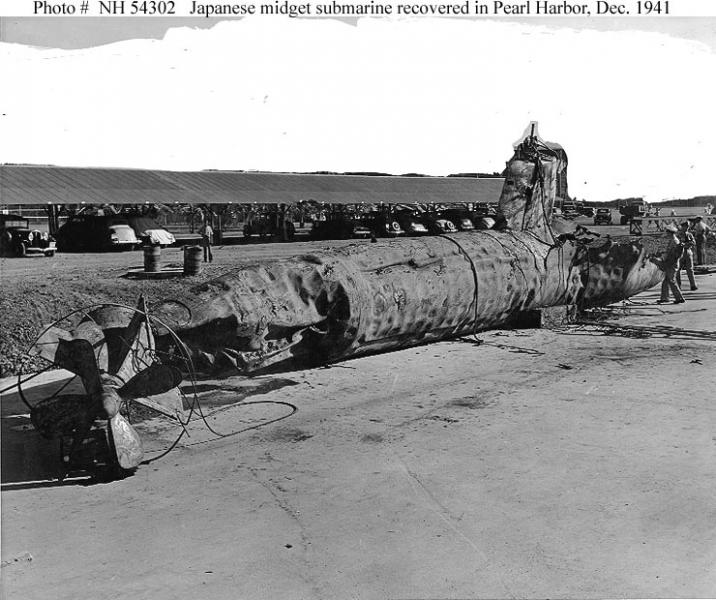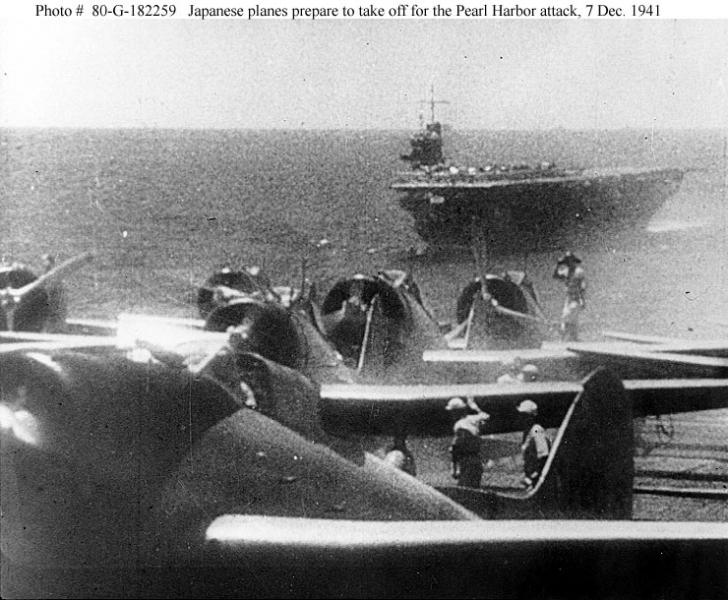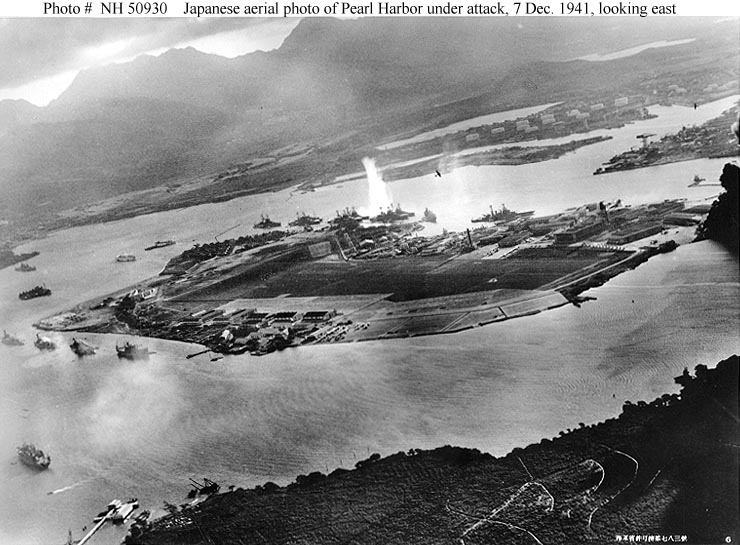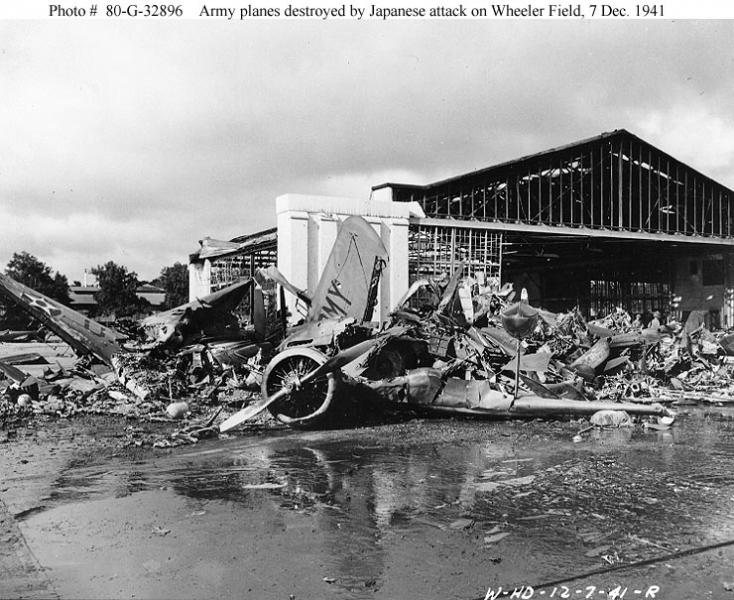Attack on Pearl Harbor
Reasons for the Pacific conflict
The economic boom of the late 19th century suddenly made Japan one of the world's leading powers. This position was further confirmed by the Japanese victories in the Sino-Japanese War of 1894 and the Russo-Japanese War of 1905.
On the other hand, Japan was economically exhausted by these wars. In the 1920s, the global economic crisis came and Japan ceased to be able to establish itself on world markets.
As a solution to the situation, certain militant circles in the Japanese government saw territorial expansion. In 1931, Japan occupied the northernmost Chinese province of Manusha, due to the local developed industry and rich deposits of raw materials.
The League of Nations and the United States were only able to verbally condemn the occupation, which further encouraged Japanese militarists. In 1937, the Japanese Armed Forces launched a war in China. The British began supplying war material to Chiang Kai-shek , while the United States imposed an embargo on exports of some items to Japan, and as relations between the two great powers worsened in the late 1930s, US President FD Roosevelt pushed for major restrictions on exporting strategic raw materials to Japan.
In addition, in September 1940, Japan signed a Tripartite Pact with Germany and Italy, gaining overseas colonies from France, which were defeated and occupied by Germany. French Admiral Darlan, the government's representative in Vichy, eventually signed an agreement with the Japanese to " jointly defend Indochina, " which in fact meant that a large area of French Indochina ( now Vietnam ) came under Japanese control and the Japanese immediately began building airports there. and naval bases, which was an unmistakable sign of further outbursts.

Signing of the Tripartite Pact by Germany, Japan and Italy on September 27, 1940 in Berlin. From left to right, Saburó Kurusu, the Japanese ambassador to Germany, Galeazzo Ciano and Adolf Hitler, Italy's foreign minister, sit.
Heinrich Hoffmann, en.wikipedia.org
On July 26, 1941, the day after the signing of the Darlan Agreement, President Roosevelt issued an order to freeze Japanese assets in the United States. Immediately, the Dutch and the English did the same. From that moment on, Japan was completely deprived of the opportunity to buy oil, which, of course, was what the Americans wanted. Their aim was to paralyze Japan's economic and therefore military potential.
Japan is now in a critical situation. It needed vital raw materials, but obtaining them peacefully was unacceptable to militant government circles in the Japanese government. In early September, the Japanese government decided that " if necessary, we will wage war against the United States, Britain and the Netherlands ." Japanese Prime Minister Konoe has been asked by militarists in the last 6 weeks to try to settle the situation through diplomacy. However, the Japanese demands ( ending aid to Chiang Kai-shek, free hands in Indochina, not increasing British and American forces in the Far East, etc. ) were unacceptable to the United States. After their rejection, Konoe resigned on October 16, 1941, and Emperor Hirohito appointed the leader of the aggressive militarists, General Tojo, as the new Prime Minister.War was now inevitable, although the emperor ordered Tojo to try to resolve the dispute peacefully.
Attack plans
In reality, however, the militarist faction has already concluded that the only solution to the situation is war and has begun extensive preparations for it. However, diplomatic negotiations continued, both for the emperor and to lull the Americans.
At the same time, the details of the Japanese war plan were specified. One of the most common misconceptions about the Pacific War is that the attack on Pearl Harbor was a key part of the plan. But that was not really the case. According to that war plan, the Japanese invading forces were to control the southern part of the Pacific, where there was mainly oil ( 65 million barrels of oil were produced annually in Sumatra, Borneo and Java ), while Thailand , the Philippines and Malaysia were to be occupied. After their control, the acquired territories were to be secured by a wide defensive arc running from the Kuril Islands through Wake Island, Marshall Islands , along the Malaysian barrier to the Burmese-Indian border.
In this initial version of the plan, the name of Pearl Harbor in Hawaii has not yet occurred. The Japanese command, of course, knew that the US Pacific Fleet was anchored at this outpost in the U.S. Navy - their future main rival, but because it knew of U.S. operational plans, it had anticipated US counterattacks in the Marshall Islands. The Japanese fleet had to wait in its own waters and then defeat the exhausted and weakened enemy in the general battle.
It was not until later that Admiral Yamamoto , the commander-in-chief of the Japanese United Navy, submitted a proposal to the Japanese General Naval Staff to destroy the US Pacific Fleet directly at its Pearl Harbor base by an air strike from aircraft carriers at the beginning of the war. From this, Yamamoto hoped in particular for the uninterrupted security of operations in the South Pacific and at the same time shaken by American determination to fight; this, he said, could force Americans to compromise. Knowing well the Yamamoto's war and industrial potential, he knew the war would need to end quickly.
However, his proposal initially met with resistance from a number of senior staff officers. They argued that Pearl Harbor was a great distance from the South Pacific, so the Pacific Fleet could not be expected to have any significant impact in the fighting in the South. Furthermore, they did not like the high risk associated with this event and feared high losses.
There was a large group of conservative officers in both the Japanese and American fleets at the time, who still considered the battleship to be the main naval combat unit and did not have much confidence in the concept of aircraft carrier operational alliances. Yamamoto eventually had to threaten resignation if his proposal was not accepted. " Operation Z, " as the plan to attack Pearl Harbor was called, was eventually incorporated into Japan's overall offensive plan.
Preparations
Once the attack was decided, all forces were set to carry it out. Problems, for example, were with anti-ship aircraft - the port was only 12 m deep, which was not enough for the then Japanese torpedoes launched from aircraft. A common mistake is to claim that the torpedoes were equipped with wooden floats to float them and prevent them from sinking deeper. In fact, they were wooden stabilizing surfaces - their task was only to stabilize the torpedo when it hit the water surface, and then they fell off.
Another problem was with the bombers - they were not effective enough to break through the armored decks of American ships.Finally, anti-tank artillery shells of 406 mm caliber were adapted by welding stabilizers on the bombs. The resulting bomb weighing 800 kg was able to reliably break through the armored decks and explode inside the ship.
Another weapon the Japanese navy decided to use when invading Pearl Harbor was the mini-corps. There were a total of 5 with two crews and two torpedoes. They were to be transported to the target by large submarines, to which the mini-submarines were attached with massive brackets. Their task was to penetrate the American port the night before the air raid and wait for the end of the air raid. Then they were to destroy important targets that would escape air torpedoes and bombs, in the ensuing confusion to cause as much damage as possible, and then use the chaos to escape back to the mother submarines.
In Hawaii itself, all sorts of intelligence were gathered diligently and sent immediately to Japan. The strike planners were especially interested in whether the anchored ships are protected by anti-torpedo nets, what is the strength of air defense, what are the habits of American crews, etc.
Due to secrecy, a northern waterway was chosen for the strike force, where there was almost no traffic due to the stormy waters. Immediately after it, a merchant ship was sent to collect meteorological information ( especially whether the stormy weather will allow refueling the battleships from the accompanying tankers ) and determine the density of traffic. In the end, refueling proved to be possible ( albeit difficult ) and no traffic was reported on the fairway.
Vessels destined for the strike force began to concentrate in Hitokappu Bay in the Kuril Islands. The ships sailed " inconspicuously " one at a time and on different courses to give the impression that their voyages were unrelated.
On December 1, the Japanese government met again. Here, Tojo reported that negotiations with the United States had failed and that the Americans had sent an ultimatum to Japan. But that was not true. The American telegram actually contained a proposal for further points to negotiate ( the Americans also played for time ). Although some members of the council were against the war, Tojo completely refused to discuss the possibility of a peaceful solution. The council eventually voted for the war. But Tojo had, in fact, long since decided. The submarines that were to support the strike force to attack Pearl Harbor set sail on November 18. On November 26, they were followed by the strike force itself, consisting of a total of 31 vessels - 6 aircraft carriers, 2 battleships, 2 cruisers, 10 destroyers, 3 submarines and 8 tankers.
Sailing to the destination
Only now was the pilots of the aircraft informed of the goal of their operation. The news of the attack on Pearl Harbor was received enthusiastically by the crews. Large models of Oahu Island and Pearl Harbor itself were uncovered on board ships. Various tactical variants, arrival formations, etc. were discussed indefinitely.
The ships observed absolute radio silence during the voyage. In case of encounters with American or neutral ships, it was decided to sink them immediately before they issued a warning. The Union worked tirelessly through the tumultuous North Pacific to its destination. The date of the attack was set for Sunday, December 7, 1941, Hawaiian time. Sunday was chosen for the lower vigilance of the American crew and the date was set with regard to the winter storms - Sunday, December 7, fell into the last weekend before their arrival.

The route of the Japanese fleet to Pearl Harbor and back
commons.wikimedia.org
On December 6, the union arrived 400 nautical miles north of Oahu. The weather was bad and it was not at all certain whether the planes would be able to take off.Nevertheless, the alliance sailed at full speed all night to reach the planned launch site by 275 miles north of Oahu by morning.
In the morning, the Japanese pilots were preparing to attack. It was to take place at 08.00 Hawaiian time. Yamamoto set the hour because he believed that half an hour earlier, Japanese diplomats would hand over a declaration of war to the US government. In reality, however, the Japanese note did not contain anything like that (except for the announcement of the futility of further negotiations ), not even the interruption of diplomatic relations. On the contrary, it contained old well-known Japanese demands not to interfere with the US in Japanese operations in China, etc. Japanese diplomat Nomura would be instructed to hand over the telegram to the Americans at 12.30 Washington time ( 07.30 Hawaiian ), but it took a very long time to translate the telegram into English and rewrite the machine, the traps were finally delivered at 14.20 Washington time, ie at a time when the attack on Pearl Harbor had long since ended…
What the Americans did
At a time when there were only hours left before the Japanese attack began, American troops on Oahu still behaved as if in the deepest peace. At the same time, the signs of the impending war were more than obvious.
In addition, the Americans had an ace up their sleeve - without the Japanese knowing it, American intelligence was able to break the Japanese diplomatic code and read secret traps. Many of these telegrams contained information that could be a clear warning - such as a question to the Hawaiian consulate about the anti-submarine networks in Pearl Harbor. Many historians have concluded that President Roosevelt knew about the attack on Pearl Harbor in advance and deliberately allowed the strike to drag the United States into the war. He was a supporter of helping Britain in its fight against Germany, but most of the American nation supported a policy of isolationism…
This theory seems to be supported by information sent in late November to all senior commanders in the Pacific, which states that " negotiations with Japan appear to be over, further Japanese action is unpredictable, but hostile acts can be expected at any moment. If hostility is inevitable, the United States wants the Japanese to take the first act. "
The US ambassador to Tokyo, J. Grew, also reported to Washington that his Peruvian colleague had informed him of the impending attack on Pearl Harbor. However, this information was rejected by Washington as unlikely, or. was considered misinformation. The Americans were well aware of Japan's interest in the South Pacific - especially the Philippines, which they considered a cornerstone of their defense plans. It was here that a large number of weapons were concentrated, which the high command promised - the brand new heavy bombers B-17 " Flying Fortress ". They did not believe in the attack on Pearl Harbor for a number of reasons. First, they greatly underestimated the capabilities of the Japanese armed forces, which they considered inferior. Secondly, the very great distance from Hawaii to Japan was considered sufficient protection.
Nevertheless, Admiral Kimmel , commander of the fleet moored in Pearl Harbor, received a telegram that said, among other things: " This telegram must be considered a war warning. Aggressive Japanese action can be expected in the next few days. " However, other text identified the Philippines, Siam, Kra or Borneo as the most exposed places.
General Short, commander of the US Army ground troops in Oahu, put his troops on alert, but he did not expect an attack from the outside - he was much more afraid of the guerrilla actions of a large Japanese minority living in the Hawaiian Islands.One of his measures ( very unfortunate, as it turned out later ) was the order to concentrate all the fighter jets, still scattered in masked shelters along the edges of the airports, right next to each other in the middle of the airfields, so that they could be more easily guarded. On the morning of December 7, American planes were crammed in even rows wing by wing.
Attack
Shortly after three o'clock in the morning on December 7, 1941, at a distance of about 10 nm from Oahu, five mini-submarines separated from five large submarines, which set out in the direction of the entrance to Pearl Harbor. Here, however, American warships patrolled. Around half past six, the destroyer Ward saw the tower of a submarine heading for the harbor. At 6:45 a.m., he destroyed it with fire and depth charges. These were the first shots of the war in the Pacific.

Destroyed Japanese minisubmarine caught by Americans ( US Navy )
The incident report was immediately sent to the superior level. However, it took a long time to decode the encrypted message, which then had to travel through various instances to Admiral Kimmel. He immediately left the house for his headquarters, but by the time he got there, air bombs had begun to explode.
The commander of the Japanese Strike Union, Admiral Nagumo , had the planes taken off earlier; due to bad weather, he feared that takeoff and flight formation would take longer. The start started at 06.00. The planes took off every 20 seconds, lined up in complete radio silence, and headed for their destination.

Japanese aircraft preparing to take off ( US Navy )
The first wave of attacks consisted of 183 aircraft, of which 140 bombers and 43 fighters. After a 100-minute flight, Japanese pilots saw 94 US warships in port ( 8 battleships, 8 cruisers, 29 destroyers, 5 submarines, 1 gunboat, 10 minesweepers, 9 minesweepers, 5 seaplane mother ships and 19 support vessels). ). To their great disappointment, there were no American aircraft carriers, the main target of their attack. The Enterprise had just returned from its journey to Wake Island, where it was carrying 12 Wildcat fighters, Lexington was transporting bombers to the Midway, Saratoga was moored in San Diego, and Hornet , Yorktown and Ranger were operating in the Atlantic to protect convoys.
The focus was on battleships, which were immediately attacked by both Bate B5N2 bombers and torpedo planes of the same type. At the same time, D3A1 Val dive bombers and A6M Zero fighters attacked American airports in Oahu and crushed the assembled planes there.

Shot from the deck of a Japanese plane during the attack on Pearl Harbor ( US Navy )
US anti-aircraft fire erupted two minutes after the raid began. The Americans recovered surprisingly quickly. However, they could not prevent the massacre.Dozens of American planes burned on the ground in an instant, only about 14 American pilots managed to take off and shoot down several Japanese planes (the total number of kills is 11 ). Torpedoes and heavy bombs have so far torn pieces of American battleships. Arizona exploded, Tennessee was on fire,West Virginia was also on fire, and with its sides pierced by 7 torpedoes, it sank to the bottom. The same fate befell Californi i. Oklahoma overturned after hitting 4 torpedoes. Better escaped Maryland , which was only slightly damaged by two bombs, Pennsylvania , standing in a dry dock, was also hit by two bombs. Nevada , damaged by a torpedo, wanted to go to sea, but after being hit by several bombs, she eventually got stuck in the shallows.

Burning Pearl Harbor after the departure of Japanese aircraft ( US Navy )
The air raid of the first wave lasted from 7.55 to 8.25. During this time, the Japanese caused 90% of the losses and lost only 9 aircraft. When the second wave of 170 Japanese aircraft ( 134 bombers and 36 fighters ) arrived at 08.50, it encountered a much better organized air defense and did not cause such damage. Instead, it lost a total of 20 machines and many others were damaged.
Around 09.45, second-wave aircraft also formed for departure. Behind them remained massive columns of thick black smoke, a total of 18 sunken or damaged American warships ( 8 battleships, 1 target, 3 cruisers, 3 destroyers, 1 workshop ship, 1 seaplane carrier and 1 minesweeper ), 188 destroyed and 159 damaged aircraft, 2,335 fallen members of the army, navy and marines ( plus 68 dead and 35 wounded civilians ) and 1,143 wounded.

Destroyed US aircraft at Wheeler Field Airport under the departure of the Japanese attack wave ( US Navy )
On board the Japanese aircraft carriers, the cheering crews began to welcome the returning first aircraft around 10 a.m. The planes landed straight out, many with almost empty tanks. 29 machines did not return at all, 80 others brought some scars. About 10 planes had to be thrown overboard for severe damage so as not to interfere with the others. All five mini-submarines, from which the Japanese command had so promised, were also lost. Not only did they not cause any damage, but they almost caused the whole event to be revealed.
Meanwhile, the air raid of M. Fuchid was reporting to Nagum on the bridge of the aircraft carrier Akagi , proposing that a third raid be carried out. Nagumo refused, saying the results had already been achieved and his task now was to bring all the ships safely back to Japan.At 13.30, the strike force took a return course.

Two waves attacking Pearl Harbor (the location of the aircraft carriers is illustrative only, in fact they were located much further north ).
Above: 0 - arriving B-17 from the States, 1 - first wave, 1-1 - " Kate " armed with bombs, 1-2 " Kate " with torpedoes, 1-3 - dive " Val ", 2 - second wave, 2 -1 - " Kate " armed with bombs, 2-1F - fighters " Zero ", 2-2 - dive "Val"
Bottom: A - Wake Atoll, B - Midway Atoll, C - Johnston Island, D - Hawaii, D-1 - Oahu, 1 - USS Lexington, 2 - USS Enterprise, 3 - Nagum Strike Association
commons.wikimedia.org
Results
The attack on Pearl Harbor is usually interpreted as a crushing Japanese victory. However, the reality was far from simple.
Of the 18 American ships hit, only 2 battleships ( Arizona and Oklahoma ) and the target ship ( Utah ) did not return to active duty, the other ships were eventually repaired, although in some cases for a very long time. In addition, the decommissioned battleships date back to World War I, and their low speed did not allow them to be incorporated into modern aircraft carrier operational alliances.
The successful air attack definitely in the US Navy silenced a large group of conservatives, clinging to battleships, as the main combat force of the navy. It was now clear that the battleships would have to relinquish their privileged position to the aircraft carriers and from now on act only as their escorts. The strike on Pearl Harbor paradoxically showed the Americans the way.
Another big mistake was the Japanese clinging to the destruction of military targets, ships and planes, as the only objects worthy of samurai attention. If they destroyed infrastructure, port facilities and, above all, huge fuel depots, Pearl Harbor would be decommissioned as an advanced naval base, leading to the withdrawal of the Pacific Fleet to the US coast.
And the last intention, namely to shake the American nation and thus impose a favorable peace on it for Japan, failed quite well. On the contrary, the insidious attack united the Americans in an unprecedented way without declaring war. Everyone now wanted a war and wanted a clear end to it - the complete and unconditional surrender of Japan. The effect was therefore exactly the opposite. Isoroku Yamamoto also felt it, saying after the attack: " I'm afraid we woke up the sleeping giant and forced him to make a terrible decision. "
Resources:
I. Hrbek, J. Hrbek: Bloody Oceans, ed. Our Army, Prague 1994, ISBN 80-206-0391-3
Lubomír Vejřík: Pearl Harbor, published by Svět křídel, Cheb 1995, ISBN 80-85280-35-3
Miloš Hubáček: Pacific in Flames, ed. Maldá fronta, Prague 2003, ISBN 80-204-0642-5
Join us
We believe that there are people with different interests and experiences who could contribute their knowledge and ideas. If you love military history and have experience in historical research, writing articles, editing text, moderating, creating images, graphics or videos, or simply have a desire to contribute to our unique system, you can join us and help us create content that will be interesting and beneficial to other readers.
Find out more